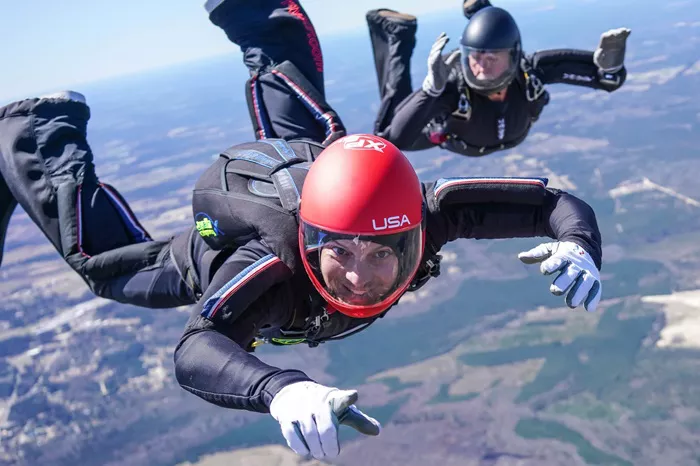Tandem skydiving is not just a leap into the unknown; it’s an adrenaline-fueled adventure that captivates both seasoned thrill-seekers and first-time jumpers alike. If you’re wondering about the intricacies of tandem skydiving training and how long it takes to prepare for that thrilling freefall, this comprehensive guide will provide all the insights you need.
Understanding Tandem Skydiving
Tandem skydiving involves a tandem instructor and a student jumper harnessed together during freefall and descent. This method allows beginners to experience the exhilaration of skydiving with minimal training. Unlike solo skydiving, which requires extensive training and certification, tandem skydiving offers a guided experience where the instructor manages the critical aspects of the jump.
see also:Choosing The Perfect Moment: When Is The Best Time To Go Skydiving?
The Basics of Tandem Skydiving
Before embarking on a tandem skydive, it’s essential to grasp the fundamental elements of this adrenaline-pumping activity:
Safety First: Tandem skydiving is regulated by skydiving organizations such as the United States Parachute Association (USPA), ensuring stringent safety standards are adhered to at all times. Instructors undergo rigorous training and adhere to strict protocols to ensure the safety of every jump.
Equipment: Participants wear a specially designed harness that connects them securely to the instructor. The instructor manages the deployment of the parachute and controls the descent, allowing the participant to focus on enjoying the experience.
Freefall Experience: During a tandem skydive, participants can enjoy up to 60 seconds of exhilarating freefall, reaching speeds exceeding 120 mph before the parachute opens. This thrilling experience offers an unmatched rush of adrenaline and breathtaking views from thousands of feet above the ground.
The Training Process
While tandem skydiving minimizes the training requirements compared to solo jumps, a solid understanding of the basics ensures a safe and enjoyable experience for all participants.
Pre-Jump Instruction
Before taking the leap, participants undergo comprehensive pre-jump training, covering essential aspects such as:
Equipment Familiarization: Participants receive detailed instruction on the tandem harness, altimeter, and other safety equipment. Understanding how each piece of gear functions instills confidence and ensures readiness for the jump.
Body Positioning: Proper body positioning during exit, freefall, and landing is crucial for a safe and enjoyable jump. Instructors emphasize the correct posture and movements to maintain stability and comfort throughout the experience.
Ground Instruction Duration
The duration of ground training can vary depending on several factors, including:
Instructional Detail: Instructors provide thorough explanations of equipment usage, exit procedures, and safety protocols, typically spanning 30 to 60 minutes. This time allows participants to ask questions and familiarize themselves with every aspect of the jump.
Interactive Learning: Ground training sessions are interactive, encouraging participants to practice simulated exits and body positioning. This hands-on approach enhances understanding and prepares participants mentally for the jump ahead.
In-Air Instruction
Once in the air, instructors continue to guide participants through every phase of the skydive:
Freefall Techniques: Instructors coach participants on maintaining the correct freefall body position, ensuring stability and comfort during the initial exhilarating seconds of the jump.
Parachute Control: Participants experience the moment of parachute deployment under the supervision of their instructor. Learning basic steering techniques allows participants to actively contribute to the descent experience, enhancing their overall enjoyment and sense of achievement.
Factors Influencing Training Duration
Several factors can impact the overall duration of tandem skydiving training:
Weather Conditions: Adverse weather, such as high winds or poor visibility, may delay jumps. Instructors prioritize safety and may reschedule jumps to ensure optimal conditions for every participant.
Group Dynamics: Larger groups may require additional briefing time to ensure every participant understands the safety procedures and logistical aspects of the jump.
Instructor Availability: The availability of qualified tandem instructors can affect scheduling. Ensuring a sufficient number of instructors allows for personalized attention and a smooth training process for all participants.
FAQs About Tandem Skydiving Training
Can Anyone Tandem Skydive?
Tandem skydiving is generally accessible to individuals aged 18 and above who meet basic health and weight requirements. Participants should be in good physical health and free from certain medical conditions that could compromise safety.
What Should I Wear for Tandem Skydiving?
Participants should wear comfortable clothing appropriate for the weather conditions on the day of the jump. Close-toed shoes are recommended, and jumpsuits and goggles are typically provided by the skydiving center.
How Safe Is Tandem Skydiving?
Tandem skydiving is statistically safe when conducted by certified instructors using well-maintained equipment. Skydiving centers adhere to strict safety standards and protocols established by governing bodies such as the USPA, ensuring a safe and enjoyable experience for all participants.
Conclusion
Tandem skydiving training offers an exhilarating introduction to the world of skydiving, combining safety with an unforgettable adrenaline rush. By understanding the training process and preparing accordingly, participants can fully immerse themselves in the thrill of freefall and the breathtaking beauty of controlled descent.
Whether you’re preparing for your first tandem jump or simply curious about the experience, knowing how long training takes and what to expect ensures a smooth transition from ground to sky. Embrace the adventure and enjoy the unparalleled sensation of soaring through the skies with tandem skydiving.
Related topics:
- Exploring The Causes Of Skydiving Fatalities: Understanding Risks And Prevention Strategies
- Surfing: The Ultimate Full-Body Workout
- Skydiving: A Thrilling Adventure Or A Terrifying Plunge?

